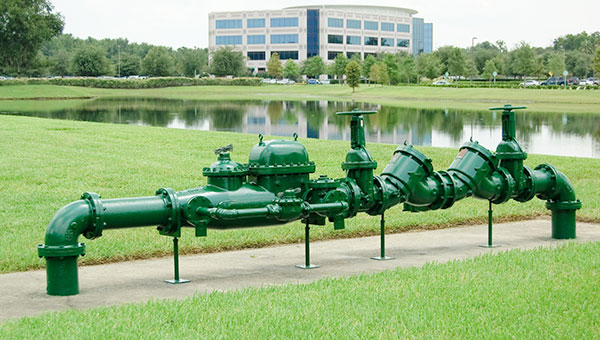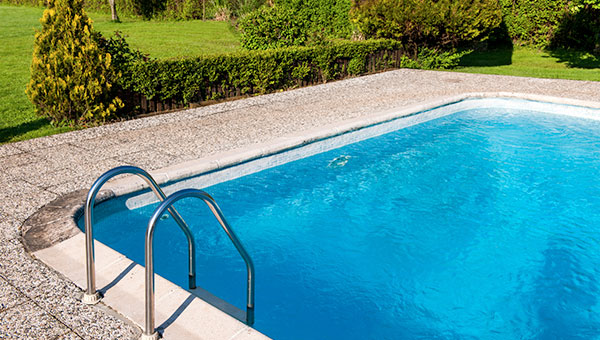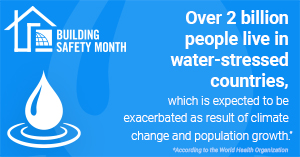
Creating a Safe & Abundant Water Supply
WEEK FOUR // May 23–31, 2022
Sponsored by:
Creating a Safe & Abundant Water Supply
WEEK FOUR // May 23–31, 2022
Sponsored by:
Clean water is the world’s most precious commodity. According to World Health Organization estimates as of June 2019, 785 million people lacked even a basic drinking-water service, including 144 million people who are dependent on surface water.
Building, plumbing and green codes help guard our potable water for future generations through proper construction, conservation and safe disposal. Code officials are vigilant protectors of our water supply. Because of their dedicated service, you can turn on the tap in your home and draw sufficient, clean water.
It is important to understand where your water comes from and what's being done (and how you can help!) to protect the water you use every day.
What is Potable Water?
Potable water is water safe for consumption. It is filtered and treated properly and is free from all contaminants and harmful bacteria meeting state and federal standards for consumption.
Where Does My Water Supply Come From?
While many might answer “from the tap”, the process of getting your water supply is a journey. Water that we use in our homes is either from a ground or surface water source. Groundwater sources include wells, while surface-water sources include rivers, lakes, and reservoirs. From there, the water may travel through different waterways to get to your kitchen sink.
If you live in the United States, your water supply may either be delivered by a public supplier, such as your local county water department, or in more rural areas, you might get your water straight from the groundwater or surface-water source. Whether your water is delivered through a system or from the direct source, your water is most likely coming from fresh groundwater sources.
- Learn more about where your water supply comes from based on your state.
- Check out the Environmental Protection Agency’s tools on data on drinking water in the United States.
- Get the World Health Organization’s Guidelines for Drinking Water Quality
How Does Potable Water Get Contaminated?
While our potable water supply may go through layers of treatment, it can also run the risk of becoming contaminated from both natural and even manmade events. Here are a few examples:
Runoff
Contamination of our potable water can primarily come from runoff, which is water pulled by gravity across the land’s surface and comes from unabsorbed water; usually from sources like rain, melted snow, or irrigation.
Storm water pollution & storm water runoff
- Precipitation has many benefits, but may also bring challenges when it comes to our water supply. Stormwater runoff has become the single largest source of pollution in many of our waterways.
- For instance, rainwater can run over built-up pollution on our streets and sidewalks. When you see that rainbow shine in puddles, you’re more than likely seeing oil or gasoline. Other pollutants in stormwater runoff include fertilizer, pesticides/herbicides, bacteria/viruses, construction waste, and trash. Stormwater unfortunately does not always go into the sewer and therefore can quickly flush into our waterways, from streams, to rivers, to the ocean.
- Check out these tips: 10 Things You Can Do to Prevent Stormwater Runoff Pollution
Urban runoff
- Urban runoff comes from sources like roofs or pavement. As more infrastructure is created in urban areas, more stormwater passes over the surface of these sources instead of being absorbed back into the earth. This lack of absorption creates the need for more drainage systems to help prevent flooding.
- In addition, with stormwater carrying a number of pollutants, the lack of absorption from this runoff creates contaminated areas, and with the increasing amount of droughts in the United States, these situations can even cause wildfires. Learn more about how to protect water quality from urban runoff
- How communities are controlling urban runoff pollution
Hazardous spills
Any release of hazardous spills in a source water area can compromise the delivery of safe drinking water to your tap. It is critical for communities to be well-informed of prompt notifications in the event of a hazardous substance spill so that local authorities can either take action to prevent the contaminated water from entering the system or minimize its consequences.
Aging infrastructure
The American Society of Civil Engineers’ 2021 report card for America’s infrastructure graded drinking water a C-. According to ASCE, there are 2.2 million miles of underground pipes in the U.S. that deliver safe water to millions of people, a system that is aging and underfunded, causing health and safety risks in our communities. The ASCE also notes that there is a water main break every two minutes and an estimated 6 billion gallons of treated water lost each day in the U.S., enough to fill over 9,000 swimming pools.
Fortunately, progress has advanced as federal funding programs continue to help revitalize water infrastructure and water utilities are reinvesting in their networks. Water systems are also working towards improving resiliency, from updating risk management plans to better prepare for emergency hazards, to investing in technologies such as sensors and water quality monitoring.
How Can I Keep My Water Safe?
As a homeowner or renter, you need to pay attention to the water supply to your home even if your community offers water and sewage treatment. Make sure that you have functioning backflow protection to prevent cross-contamination while doing things like filling backyard swimming pools.
Backflow Protection
Backflow occurs when water is caused to flow in an opposite direction due to pressure changes in the pipes. This backflow can contaminate the public drinking water with fertilizer, pesticides, human waste, chlorine from pools/spas, and soap from your sink, dishwasher, and shower. Backflow prevention devices can be installed on your home's water pipes to prevent this from happening. These devices only allow water to flow in one direction. It is recommended to have a backflow preventer installed anywhere incoming water and wastewater might be cross-connected.
Water Supply Cross Connection
Here are some tips you can follow to help keep our water safe:
- Don't dump hazardous waste on the ground. It can contaminate the soil, which could also contaminate the groundwater or nearby surface water.
- Don't overuse pesticides or fertilizers. Many fertilizers and pesticides contain hazardous chemicals which can travel through the soil and contaminate groundwater.
- Never flush nondegradable products down the toilet. Your toilet is not a trash can.
- Scooping up pet waste keeps bacteria from running into storm drains and water supplies.
More Resources to Check Out
- Private Sewage Disposal: Flushing Out the Facts
- How to Identify Lead Free Certification Marks for Drinking Water System & Plumbing Products
- How to make your water safe to drink in an emergency
- Just the Facts: Legionella and Water Supply Systems
Former Code Council Senior Director of PMG Resources Lee Clifton speaks with backflow prevention specialist Bruce Rathburn about plumbing cross-connection control programs. Listen to the podcast.
Join the Virtual Event!
Week 4 Event #1:
Backflow Basics:
Repair & Testing
Tuesday, May 24
2–3:30 pm ET

Water Conservation & Reuse Strategies
Water conservation and efficiency has become increasingly important in recent years due to water scarcity, droughts, and water contamination in many areas of the world. Right now, global and regional agencies are working together to address water shortages and water pollution, but they need support. While the world water crisis is certainly daunting, there are things we can all do to help.
Tips for Conserving Water at Home
- Don’t flush trash down the toilet. Five to seven gallons of water are wasted every time you flush a cigarette butt, facial tissue or other small bit of trash.
- Check your toilets, faucets and pipes for leaks regularly.
- Install water-saving shower heads and low-flow faucet aerators.
- Use your water meter to check for hidden water leaks.
- Insulate your water pipes.
- Take shorter showers. The recommended time is 5 minutes.
- Don’t run the water while brushing your teeth.
- Only wash clothes and run the dishwasher when there is a full load.
- Don’t leave the water running when washing dishes by hand.
View our Everyone Needs Water brochure to learn more about ways to conserve water.
Water reuse recycles water from a variety of sources to treat and reuse it for beneficial purposes like agriculture and irrigation and potable water supplies. As world water consumption rises, water reuse becomes increasingly important in enhancing our water security, sustainability and resilience.
Learn about best management practices from the National Blue Ribbon Commission to support the use of onsite non-potable water systems to be reused in a building.
Check out our Non-potable Water Reuse brochure to learn more about the emergence of non-potable water reuse systems as a non-conventional water resourcere.
Desalinization Plants
Experts agree that desalination is one way to help extend the water supply. Desalination is a way to treat and use salt water to create a freshwater supply. The process has different methods of converting saltwater to potable drinking water, from the thermal, or distillation process, to reverse osmosis and electrodialysis, all of which force the salts to separate from the water. This process is being used more and more around the world to give people readily available access to a fresh water supply. This means coastal cities can use desalination on seawater, or landlocked cities can use this process on brackish water, for their water supply.
Trends in Water Reuse Today
PMG Executive Director Matt Sigler gives an update on key takeaways from the 2022 Water Reuse Symposium.
The Code Council in Action
HERSH20
In 2018, The International Code Council and the Residential Energy Services Network (RESNET) collaborated to develop a water ratings standard, known as HERSH20, that builders can use in the U.S. to evaluate and market a home’s water usage efficiency. Since this program began, the organizations further developed RESNET/ICC Standard 850-2020 — ANSI/RESNET/ICC 850-2020 Standard Calculation and Labeling of the Water Use Performance of One-and Two-Family Dwellings Using the Water Rating Index, which sets the technical specifications for the inspection, testing and labeling of a home’s water efficiency. In 2021, the California Energy Commission’s accredited rating providers, CalCERTS and CHEERS, were also approved by RESNET as official HERSH20 providers – paving the way for the launch of the water efficiency rating program in California.
WaterSense
The U.S. Environmental Protection Agency’s (EPA’s) WaterSense Program is a major water efficiency initiative based in the U.S. This important initiative was developed to help consumers identify water efficient products that meet EPA’s criteria for efficiency and performance. Since its creation in 2006 through the end of 2018, WaterSense has helped Americans save a cumulative 3.4 trillion gallons of water and more than $84.2 billion in water and energy bills, according to the EPA. Additionally, the use of WaterSense labeled products saved 462.5 billion kilowatt-hours of electricity. ICC Evaluation Service (ICC-ES), a member of the Code Council’s family of solutions and an industry leader in technical evaluations of building products, is an EPA-licensed certifier. To learn more about ICC-ES WaterSense Programs, click here.
The International Codes and Water Safety
Building codes and standards like the International Plumbing Code (IPC) continue to build upon previously established water efficiency standards by going through a regular update process. The most recent edition provisions ensure safe and sanitary access to clean water as well as efficiency measures for water use. For example:
- Chapter 13 of the 2021 IPC has water conservation measures for on-site water re-use such as greywater, re-claimed water, and rainwater collection;
- Also new to Chapter 13 of the IPC is the referencing of the joint CSA B805/ICC 805-2018 Rainwater Harvesting Systems Standard as an alternative for regulating the materials, design, construction and installation of systems for rainwater collection, storage, treatment and distribution of nonpotable water; and
- Chapter 14 of the IPC addresses the use of these water re-use provisions through sub-surface landscape irrigation requirements.
Learn more about the International Plumbing Code.
Here’s Why Adopting a Suite of Codes is Important for Water Efficiency and Conservation.
More Resources to Check Out
- Facilities.net: Water Conservation and Restroom Design
- Water Reuse Resources by State
- FEMA Public Assistance Grant Program Available to Water and Wastewater Utilities
Swimming Pool and Backyard Safety
During warm weather seasons, homeowners and renters should take the time to check their outdoor areas for potential safety hazards. Proper inspections now can help to keep your family and friends safe in the future.
Nationally, drowning is a leading cause of death for children under the age of five. Practice constant, adult supervision around any body of water, including pools and spas. And, if you're considering a swimming pool purchase, contact your local Building Department first to determine exactly what permits are needed and what requirements you must follow.
Check out these 10 Important Tips to Remember for Backyard and Pool Safety.
How Can We Stay Safe Around Swimming Pools?
Take the Pool Safety Pledge
Pool Safely is a national public education campaign that works with partners around the country, including the Code Council, to reduce child drownings and entrapments in swimming pools and spas. Take the pledge and get a free pool safety kit.
Get familiar with the swimming pool safety codes in your area
The Pool & Hot Tub Alliance promotes safe and healthy pool and hot tub environments for people to share enjoyable aquatic experiences. They’ve compiled a listing of swimming pool safety codes by state, city and county. Learn more about pool safety codes in your area.
The Code Council in Action
The Code Council supports drowning prevention and is an active supporter of the National Drowning Prevention Alliance.
The Code Council provides building safety solutions, technical resources, product certification and training for plumbing and swimming pool professionals – part of what is known as our PMG program. The acronym PMG refers to model codes, standards, services and resources related to plumbing, mechanical, fuel gas and swimming pools. Learn more about our PMG program.
More Resources to Check Out
Join the Virtual Event!
Week 4 Event #2:
Pool Owner Safety 101
Wednesday, May 25
2–3 pm ET




